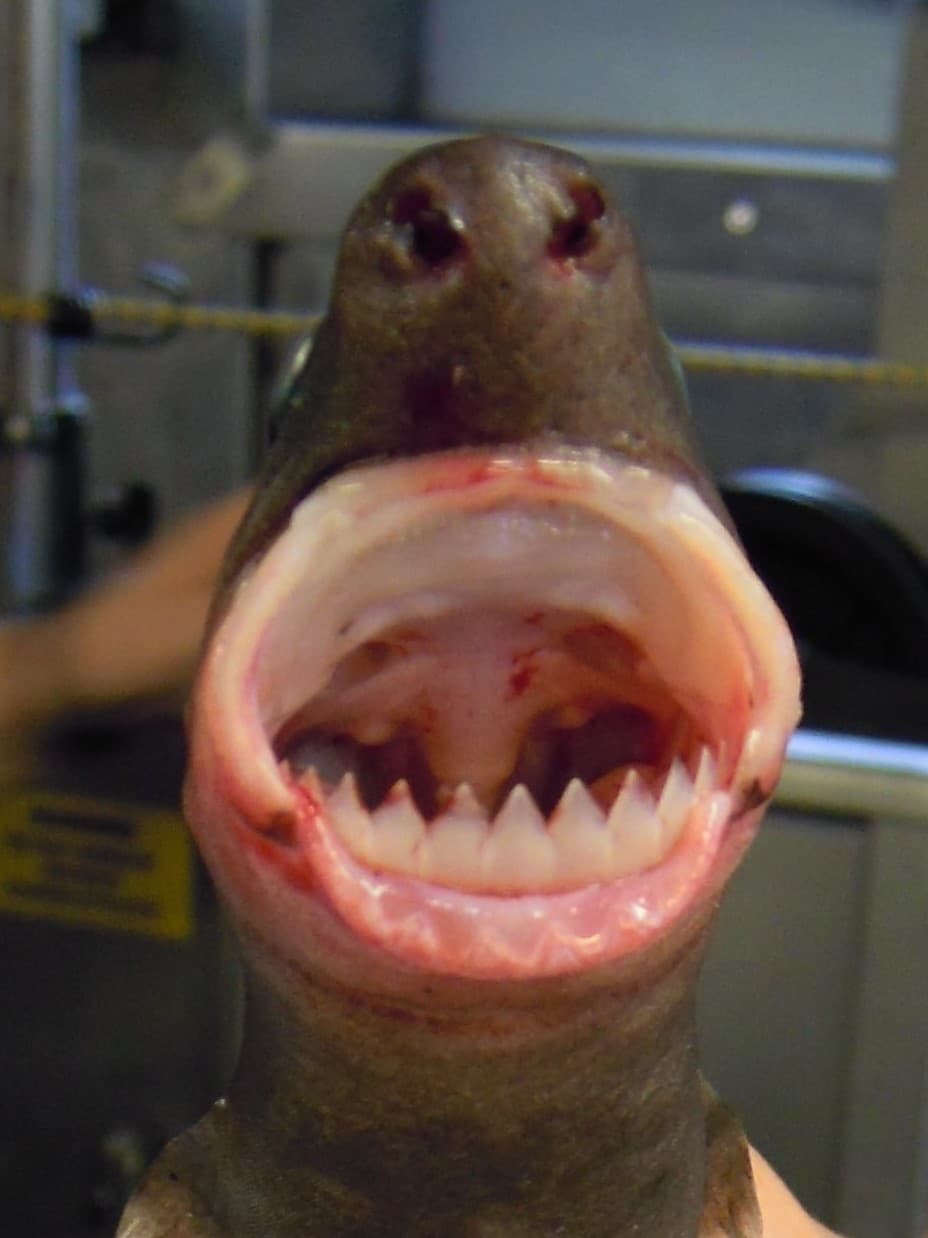Yes, there really is a “cookie” shark. They are called cookiecutter sharks because they carve out a circular plug of flesh when biting their prey. Only one or two feet long, these aggressive sharks are willing to attack a wide variety of marine animals, including tuna, seals, dolphins, and even great white sharks. They have been known to bite humans, leaving a crater-like wound that requires plastic surgery.
Amazing Facts About the Cookiecutter Shark:
- Cookiecutter sharks are small, only one or two feet long.
- They are remarkably aggressive and will attack much larger prey.
- They are considered parasites, since they feed on larger animals without killing them.
- Their teeth are in a row along the lower jaw, unlike those of other sharks.
- Relative to the size of their jaws, cookiecutters have the largest teeth of any shark.
- Cookiecutters bite their prey and then spin to pull out a circular plug of flesh.
- They have a very unusual mouth with big lips that create a suction attachment to their prey using suction from the lips and unique pharynx.
Why are They Called Cookiecutter Sharks?
It is called a cookiecutter shark because it takes a perfectly round, cookie-sized plug of flesh from its prey.
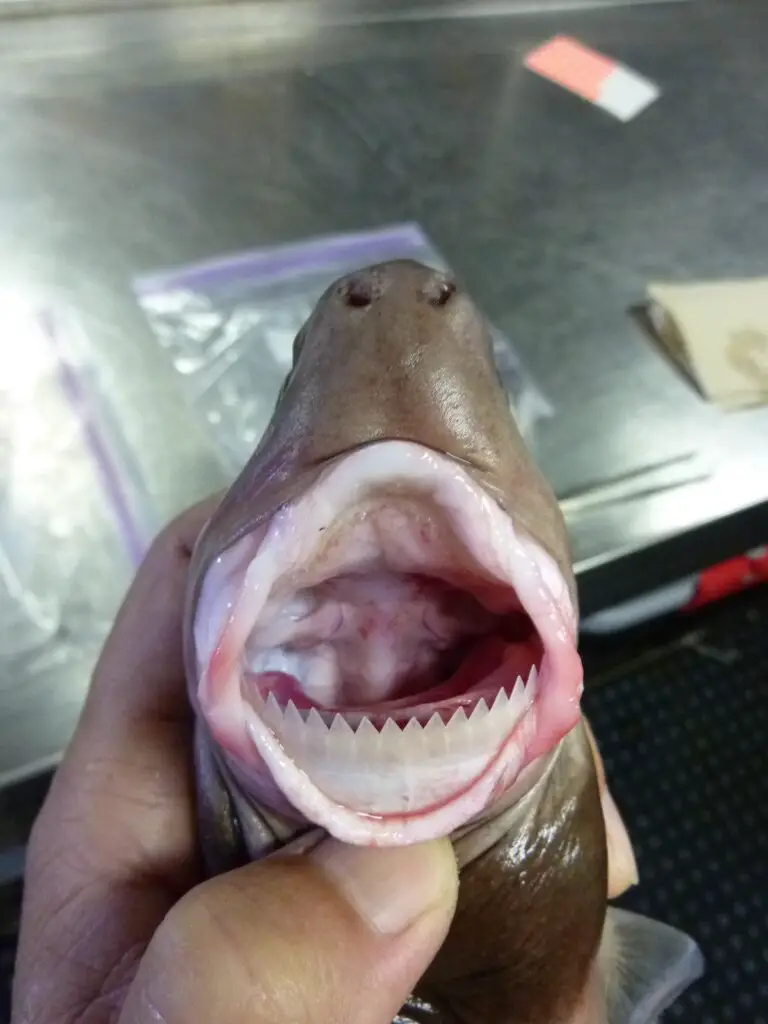
Do Cookiecutter Sharks Bite Humans?
Yes, cookiecutter sharks have attacked and bitten humans, but the odds of being bitten are tiny, so there’s little to be concerned about.
The first recorded cookiecutter shark attack on a live human was described in an article co-authored in 2011 by researchers from the University of Florida.
Of the more than 6,400 records of shark attacks recorded by the ISAF, two previous instances of unprovoked cookiecutter bites are documented: one in 2009 in Hawaii’s Alenuihaha Channel and one in 2017 in North Queensland, Australia.
In 2019, there were three documented attacks by cookiecutter sharks, and all occurred on nighttime long-distance swimmers practicing in Hawaii’s Kaiwi Channel.
Swimmers are less likely to encounter these sharks during the day since they tend to stay in deep ocean waters until night. Every day, they migrate up to 3 km (1.9 mi) vertically, approaching the surface at dusk to feed and descending in the morning.
Do Cookiecutter Sharks Hurt?
Losing a chunk of flesh can never be pleasant, so yes, a cookiecutter shark bite would be painful. It would hurt like…(insert your favorite expletive).
In addition to being painful, a cookiecutter shark attack presents a challenging recovery situation. The bite creates permanent tissue loss and plastic surgery is required to close the wound.
Luckily, these sharks are not large, but you wouldn’t want to be bitten by one. They might not look as impressive and terrifying as a great white shark, and one bite from a cookiecutter shark might not kill you, but you would have a lasting memory along with a lifelong scar as a souvenir.
Adaptations to a Parasitic Lifestyle
Cookiecutter sharks are considered parasitic, due to their propensity for feeding on larger animals without killing them (Papastamatiou et al. 2010).
These sharks have very small fins and have adapted to hovering in the water column. This may seem odd for a species of shark that primarily inhabits open ocean. However, rather than chasing their prey all over the ocean, they’ve developed a few tricks to help attract predators.
That’s right – cookiecutter sharks want large predators to notice them! It’s all part of their master survival strategy. And it works.
Here’s an excellent short BBC video about the cookiecutter shark.
First, they have a brown collar right behind the head often referred to as a dog collar because of the appearance.
This collar resembles the silhouette of a small fish, which may attract large animals looking for an easy meal.
Second, cookiecutters also have light emitting photophores along their underside, which may serve to attract predators.
You might be interested in learning Why Deep Sea Fish are So Weird and Ugly? (Warning: Scary Pictures!)
How do Cookiecutter Sharks Attack Much Larger Prey?
One of the big mysteries surrounding cookie cutter sharks is how they manage to approach their prey and take a bite out of animals that are much larger than themselves.
Cookiecutter sharks probably rely on cunning and deceit more than anything to bite larger, more energetic prey.
The variety of animals that cookie cutter sharks are willing to bite and attack distinguishes this from other species of shark. They will attack anything, including orcas, great white sharks, marine mammals, and even submarines.
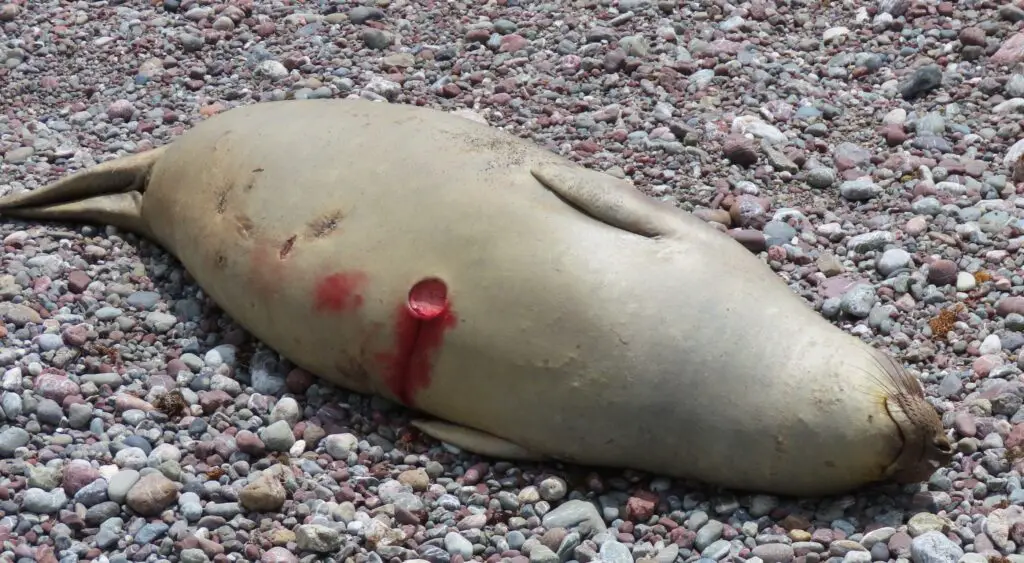
Once an animal approaches a cookiecutter shark, they will find the tables turned and predator becomes prey. Somehow, these small sharks swim up and attach themselves to the side of their prey, possibly using a vacuum.
Once attached, the shark carves out a circular, golf-ball sized piece of flesh using its razor-sharp set of triangular-shaped lower teeth, probably with a spinning and twisting motion.
Cookiecutters are bioluminescent, producing their own light on specific body sections, like squid.
According to researchers, the sharks may use this camouflage ability to hide among squid as bigger fish, including tuna, feed on the squid. The larger fish are surprised when the sharks attack them and take a bite before vanishing from the area.
What Makes the Cookiecutter Shark so Unique?
Most cookie cutter sharks are less than two feet long and have an unusual shape compared to other shark species. They are shaped like big brown cigars.
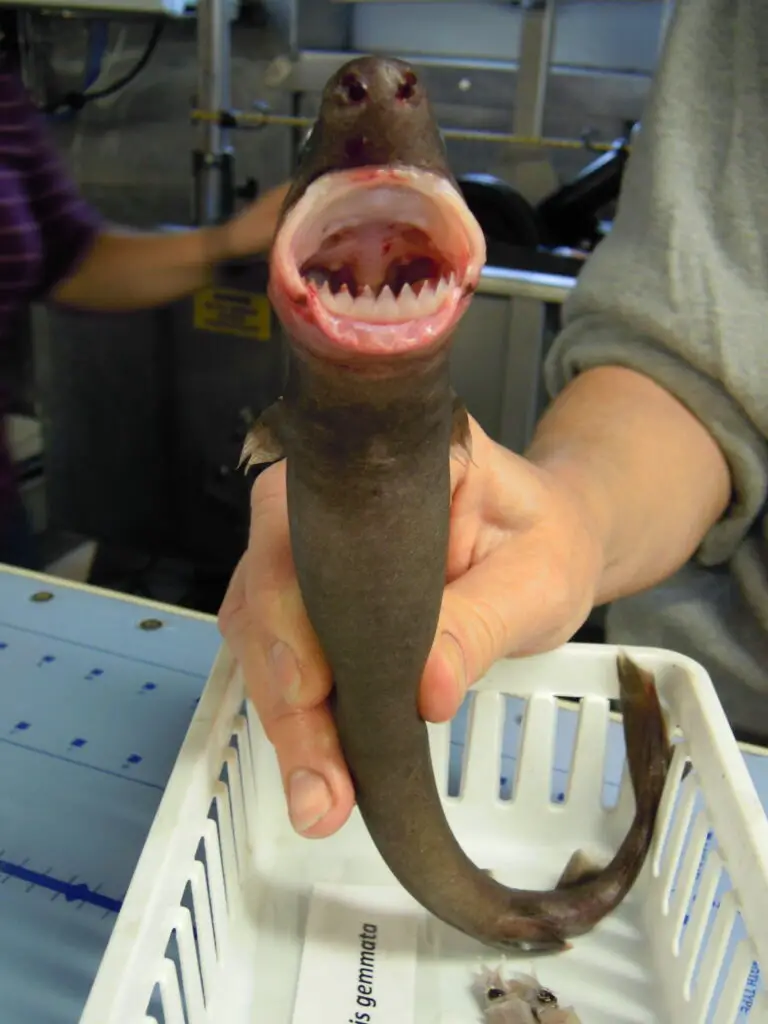
The lips around the small, transverse mouth are big and fleshy. As we have seen, the mouth has the form and function of a suction cup.
They have plenty of teeth. The upper jaw has 25–31 teeth while the lower jaw has 30–37 teeth, increasing with age and body growth.
The upper teeth are very different from the lower teeth. The upper teeth are short, narrow, erect, and taper to a single cusp with a smooth edge. The lower teeth are broader and knife-like, and interlock to create a single cutting edge that resembles a saw.
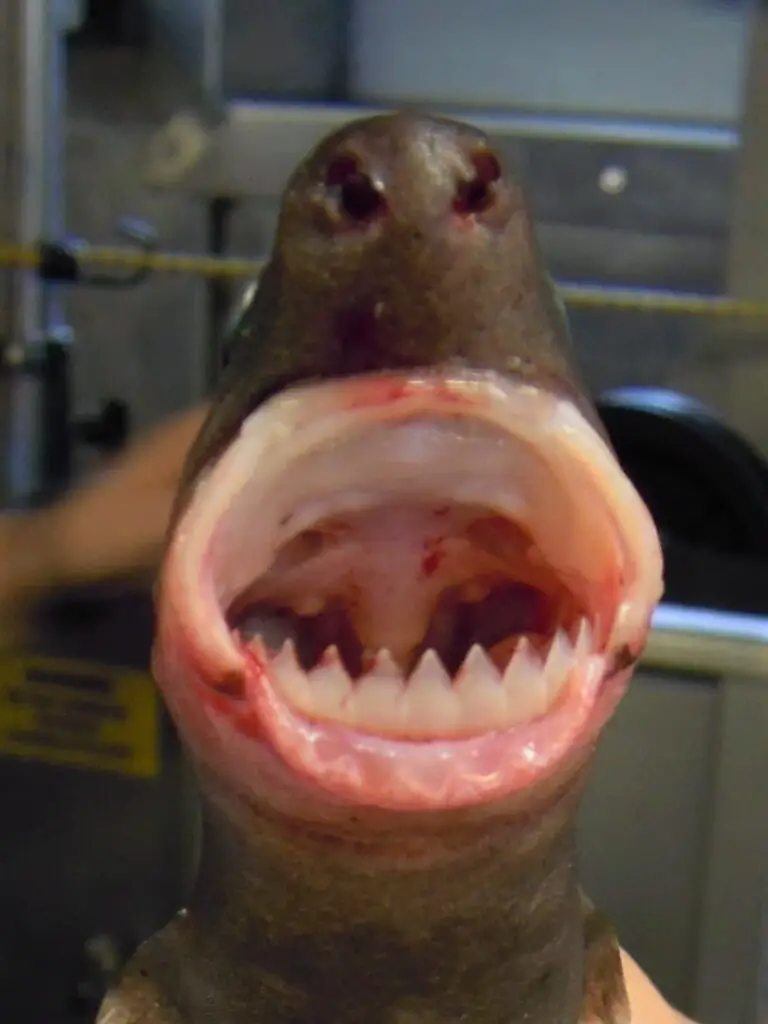
Learn more about the fascinating – and slightly creepy – cookiecutter shark by watching this video:
References
International Shark Attack File (ISAF). The ISAF investigates all human-shark interactions, but focuses its annual report on unprovoked attacks, which are initiated by a shark in its natural habitat with no human provocation. https://www.floridamuseum.ufl.edu/science/tag/international-shark-attack-file/
Papastamatiou, Yannis P., Bradley M. Wetherbee, John O’Sullivan, Gwen D. Goodmanlowe, and Christopher G. Lowe. 2010. “Foraging ecology of Cookiecutter Sharks (Isistius brasiliensis) on pelagic fishes in Hawaii, inferred from prey bite wounds.” Environmental Biology of Fishes 88, 4 (2010): 361-368. doi:10.1007/s10641-010-9649-2.
See Our TOP Articles for Even More Fascinating Creatures
- Why Are Male Birds More Colorful? Ins and Outs of Sexual Selection Made Easy!
- Why is the Cassowary the Most Dangerous Bird in the World? 10 Facts
- Why are Animals of the Galapagos Islands Unique?
- How do Octopus Reproduce? (Cannibalistic Sex, Detachable Member)
- How Smart are Octopuses? Are Octopuses As Intelligent as Dogs?
- How do Electric Eels Shock Their Prey? Can an Electric Eel Kill You?
- Do Jellyfish have Brains? How Can they Hunt without Brains?
- Why are Deep Sea Fish So Weird and Ugly? Warning: Scary Pictures!
- Are Komodo Dragons Dangerous? Where Can you See Them?
- Koala Brains – Why Being Dumb Can Be Smart (Natural Selection)
- Why do Lions Have Manes? (Do Dark Manes Mean More Sex?)
- How Do Lions Communicate? (Why Do Lions Roar?)
- How Dangerous are Stonefish? Can You Die if You Step on One?
- What Do Animals Do When They Hibernate? How do they Survive?
- Leaf Cutter Ants – Surprising Facts and Adaptations; Pictures and Videos
- Irukandji Jellyfish Facts and Adaptations; Can They Kill You? Are they spreading?
- How to See MORE Wildlife in the Amazon: 10 Practical Tips
- Is it Safe to go on Safari with Africa’s Top Predators and Most Dangerous Animals?
- What to Do if You Encounter a Bullet Ant? World’s Most Painful Stinging Insect!
- How Do Anglerfish Mate? Endless Sex or Die Trying!
- How Smart are Crocodiles? Can They Cooperate, Communicate…Use Tools?
- How Can We Save Our Oceans? With Marine Sanctuaries!
- How Do African Elephants Create Their Own Habitat?
- What is Killing Our Resident Orcas? Endangered Killer Whales
- Where Can You See Wild Lemurs in Madagascar? One of the Best Places
- Where Can You see Lyrebirds in the Wild? the Blue Mountains, Australia
- Keeping Mason Bees as Pets
- Why do Flamingos have Bent Beaks and Feed Upside Down?
- Why are Hippos Dangerous? (Do They Attack People?)

